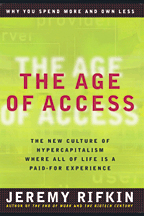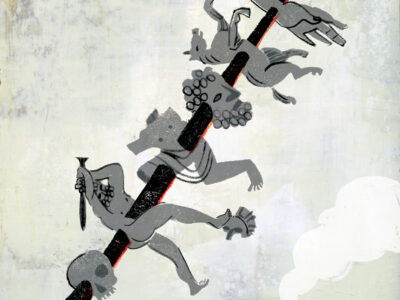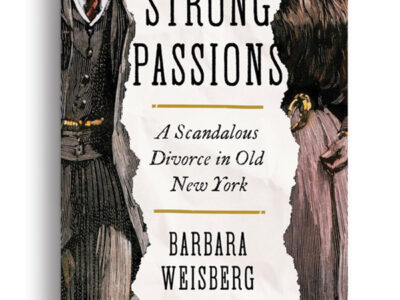Where do you want to go—that is, what do you want to buy—today?
By Harry Goldstein

THE AGE OF ACCESS: The New Culture of Hypercapitalism
Where All of Life is a Paid-for Experience
By Jeremy Rifkin W’67
New York: Jeremy P. Tarcher/Putnam, 2000.
312 pp., $24.95
Order this book
Provocateur par excellance Jeremy Rifkin sets himself a daunting task in The Age of Access: The New Culture of Hypercapitalism Where All of Life Is a Paid-for Experience. In it he tries to come up with a unified theory of exactly how and why techno-capitalism is moving away from physical commodities and traditional markets and toward digital networks where the only thing being bought and sold is experience itself. The copious footnotes and extensive bibliography underscore the fact that Rifkin is foremost a fantastic aggregator of statistics and opinions that bolster his compelling premise.
One of the last and loudest voices of the New Left, Rifkin’s stock-in-trade as an economist and president of the Foundation on Economic Trends is to spot significant emerging social, economic and cultural
developments. In The Age of Access he follows the trajectory of hypercapitalism’s progress to the point at which, he argues, it could well end—with the atomization of human society and culture and the fracturing of our own individual identities.
Each of Rifkin’s books forces us to question the inevitable march of global capitalism. His oeuvre comprises one long list of controversial, distinctly dystopian, anti-capitalist polemics—from his two most recent books, The Biotech Century and The End of Work, back to Who Should Play God?and Own Your Own Job. These books dissect the whys and wherefores of power relations in a world where capitalism stands triumphant.
The End of Work in particular asks a number of questions that bear directly on his thesis in The Age of Access. What’s going to happen when robots can put a car together from hood ornament to digital dashboard? When harvesting wheat, as well as planting it, is completely automated? When voice-recognition programs make keyboards obsolete—along with the (human) word processors whose jobs are attached to them? The Age of Access asserts that we’ll simply have more time to practice our starring role as consumers in the New Economy.
Rifkin develops this idea by exploring how we are daily becoming more connected, more networked, than ever, while simultaneously being parsed into our constituent desires so that we can most efficiently digest a global monoculture whose sole purpose is to create and then satisfy the isolated consumer’s insatiable appetite for mediated experience.
First, Rifkin argues that our notion of property is changing radically. No longer are people tied to the idea of owning a car or a house—instead, individuals (especially the affluent) are content to lease luxury cars and live in gated communities where their rights as homeowners are superseded by the collective. This same population enjoys access to the electronic networks necessary for connecting individuals to corporations and therefore have available an array of virtual experiences in which identity is as fluid and changeable as the roiling ocean—which these same people will pay to experience firsthand (witness the growing adventure-travel and eco-travel industries) or work to recreate as a virtual experience for others to buy.
As Rifkin points outs, the metamorphosis from industrial production to cultural capitalism is part and parcel of a shift from the work ethic to the play ethic. “Transnational media companies with communications networks that span the globe are mining local cultural resources in every part of the world and repackaging them as cultural commodities and entertainments,” Rifkin writes. “The top fifth of the world’s population now spends almost as much
of its income accessing cultural experiences as on buying manufactured goods and basic services.”
The lifetime value (LTV) of a consumer is now the primary measure of the man (and woman) from the corporate perspective. Marketing has taken over from production and production has been turned over to robots, computers and the neural nets and artificial-intelligence software that will increasingly run the show. Rifkin predicts that by 2050 as little as five percent of the population will be needed to manage and operate the traditional industrial sphere.
So what’s left for people to do with all of this leisure time except consume cultural experiences and evolve human consciousness to another stage? “Protean humans”—the generation that has grown up with the Web and high-octane electronic games (a $6 billion interactive industry that Rifkin strangely omits from his sprawling critique), satellite television, theme restaurants and whole theme-cities, cell phones, handheld computers, the Human Genome Project and Dolly the cloned sheep, not to mention the dot-com boom (and bust)—will propel us inexorably, Rifkin says, to the ultimate stage of cultural capitalism. Certainly the culture industry is already employing these dot-com-ers in increasing numbers, and the future belongs to them. Unfortunately, it is the realm of these techno-prodigies that Rifkin sees through a glass darkly, or perhaps not at all:
“A number of psychologists and sociologists are beginning to worry that the generation that is growing up in simulated worlds and becoming comfortable with the idea of buying access to cultural commodities and lived experiences might not have sufficient emotional experience to empathize. Their concerns are compounded by what they observe as the increasing fragmentation of personal consciousness—multiple personas—among members of the dot-com generation … A generation that is unable to feel for one another is incapable of creating the social trust that is so essential to maintain culture.”
The old radical always casts a jaundiced, wary eye on the new. The huge protests that have taken place over the course of the past year or so, first in London, then Seattle, and most recently in Washington, D.C. were in fact driven to a great extent by dot-com-ers who have harnessed the Internet to organize, not only themselves, but also various activist constituencies, most notably good old industrial trade unions. Are these protean people so incapable of empathy that they are unworthy to take the mantle of social responsibility from self-satisfied and often arrogant boomer activists? Ultimately, Rifkin’s Luddite streak prevents him from being able to fully imagine a radically different ontology, one that is being created and recreated millions of times every day by people eager to express their own individuality and to experience that of others. Still, protean, Luddite and consumer alike should heed Rifkin’s analysis, if only to note what we’re buying and what kind of price we’re paying for access to each other and ourselves now and in the future. Caveat emptor, the show must go on.
Harry Goldstein is editor/analyst of Inside R&D, a weekly newsletter that tracks technological developments worldwide. He has written about science and technology for Fox News, CBS Healthwatch, Utne Reader and the Gazette.
Architect’s Reputation Restored

WILLIAM L. PRICE:
Arts and Crafts to
Modern Design
By George E. Thomas Gr’75, Faculty. Introduction by Robert Venturi Hon’80.
Princeton Architectural Press, 2000. 376 pp., $42.00.
Order this book
Even scholars of modern design have forgotten the impact of Will Price (1861-1916), whose mature work fired the imagination of his peers and shaped the Art Deco architecture of the next generation. This book—and a new exhibit at Penn’s Arthur Ross Gallery—should return the turn-of-the-century modern architect and Penn studio critic to his rightful place in American history.
William L. Price began his architectural training in the Philadelphia office of Frank Furness, where, a few years before, Louis Sullivan had been exposed to the idea of an American architecture as contemporary as the American democracy. In the 1880s, Furness’s free style was under attack by historicists. Price adopted the new taste, but as the 20th century dawned he heard the clarion call of the future. By 1901 he had founded two experiments in communal living (at Rose Valley and Arden in Pennsylvania), and the following year he formed a partnership to work across the nation with Martin Hawley McLanahan(1865-1929). In those years, construction standards for reinforced concrete were being established at Penn’s Towne School. Over the next 15 years, Price and McLanahan built concrete structures from Atlantic City to Chicago and from Philadelphia to Florida.
Price quickly grasped the link between modern design and modern life, which he summarized in 1904: “This is America, and art is the utterance of the living not the dead.” By 1905 he had devised a system of design that distilled the facts of construction and function into an aesthetic unity. His mature work was best represented by the Traymore Hotel in Atlantic City, whose tapering stepped forms made it the signature building of its era. Price and McLanahan designed many of the train stations of the Pennsylvania Railroad between Pittsburgh and Chicago, as well as an important cluster of houses in Indianapolis for the automobile promoters who founded the Indianapolis Motor Speedway and later developed much of modern Miami. Those promoters commissioned Price’s firm to design Miami’s Aquarium, Flamingo Hotel and Star Island, introducing the modern style for which that resort became famous.
More than a decade after Price died in 1916 at the age of 54, he was remembered by Paul Cret as one who “shaped the present tendencies of American architecture.” In 1930, another veteran of Furness’s office, George Howe, while completing the design for Philadelphia’s landmark PSFS skyscraper, wrote that “Wright, Sullivan and Price were among the first to grasp the architectural possibilities of the new life and the new means of construction. Their names were known in Europe, while they still remained comparatively obscure among their fellow countrymen.” Price has been so completely forgotten that scholars of modern design would be forgiven for not knowing which Price Howe meant. With this book and exhibition, now they will.
“The Architecture of William L. Price: From Arts and Crafts to Modern Design” is on display at the Arthur Ross Gallery through Aug. 6, and at the National Building Museum in Washington, from Dec. 1 to April 29, 2001. (Guest curator, George E. Thomas; exhibit design, David Slovic G’66.)
BRIEFLY NOTED
A selection of recent books by alumni and faculty, or otherwise of interest to the University community. Descriptions are compiled from information supplied by the authors and publishers.
CITY OF SISTERLY AND BROTHERLY LOVES:
Lesbian and Gay Philadelphia, 1945-1972
By Marc Stein Gr’94.
Chicago: The University of Chicago Press, 2000. 457 pp., $35.00.
Order this book
Taking an in-depth look at Philadelphia from the 1940s to the 1970s, the author finds a city of vibrant lesbian and gay households, neighborhoods, commercial establishments, public cultures and political groups. In doing so, he shatters the myth that lesbian and gay history began with the 1969 Stonewall riots in New York and challenges the notion that only New York and San Francisco featured major lesbian and gay communities in the pre-Stonewall era. Stein, formerly editor of Gay Community News in Boston, is now assistant professor of history at York University in Toronto.
ACROSS THE OPEN FIELD:
Essays Drawn from English Landscapes
By Laurie Olin, Faculty.
Philadelphia: University of Pennsylvania Press, 2000. 352 pp., $42.50
Order this book
“Twenty-eight years ago I went to England for a three-month visit and rest. What I found changed my life.” So begins this memoir by one of America’s best-known landscape architects, Laurie Olin. Raised in a frontier town in Alaska, trained in Seattle and New York, Olin found himself dissatisfied with his job as an urban architect and accepted an invitation to England to take a respite from work. What he found, in abundance, was the serendipity of a human environment built over time to respond to the land’s own character and to the people who lived and worked there. For Olin, the English countryside was a palimpsest of the most eloquent and moving sort, yet whose manifestation was of ordinary buildings meant to shelter their inhabitants and further their work. This book is as much a plea for saving the modern American landscape as it is a passionate exploration of what makes the English landscape so characteristically English. Olin is the Practice Professor of Landscape Architecture and Regional Planning.
SCENES OF INSTRUCTION: A Memoir
By Michael Awkward Gr’86, Faculty.
Durham, N.C.: Duke University Press, 2000. 208 pp., $24.95.
Order this book
Structured around the commencement ceremonies that marked his graduation from various schools, this memoir presents Awkward’s coming-of-age as a bookish black male in the projects of 1970s Philadelphia. His relationships with his family and peers, their struggles with poverty and addiction, and his eventual move from underfunded urban schools to a prestigious private school all become parts of a memorable script. With a recurring focus on how his mother’s tragic weaknesses and her compelling strengths affected his development, Awkward, a professor of English, intersperses the chronologically arranged autobiographical sections with ruminations on his own interests in literary and cultural criticism. By connecting his personal experiences with larger political, cultural and professional questions, Awkward uses his life as a palette on which to blend equations of race and reading, urbanity and mutilation, alcoholism, pain, gender, learning, sex and love.
A DOG’S GUIDE TO LIFE: The Bala Diaries
By Marc Handelman C’85.
New York: Horodias, 2000. 142 pp., 14.00.
Order this book
This is the personal diary of Bala, an insightful Doberman from Manhattan who sniffs for clues to life’s great mysteries, such as how not to get left behind, the sexual politics of the local dog run and the allure of chicken wings. He also offers a dog’s eye view of his yuppie “Mom” and “Dad” and their obsessions—including himself, money and religion—while teaching the reader a thing or two about love and relationships. Handelman is a fiction writer, playwright and newsletter publisher.
THE WAGES OF SIN: Sex and Disease, Past and Present
By Dr. Peter Lewis Allen WG’00.
The University of Chicago Press, 2000. 202 pp., $25.00.
Order this book
Near the end of the century, a new and terrifying disease arrives suddenly on the continent. Infecting people through sex, it storms from country to country, defying all drugs and medical knowledge. The deadly epidemic provokes widespread fear and recrimination; authorities call it “the just rewards of unbridled lust.” The time was the 1490s; the place, Europe; the disease, syphilis. Throughout history, Western society has often viewed sickness—especially diseases tied to sex—as a punishment for sin. This book shows how society’s views of particular afflictions often heightened the suffering of the sick and substituted condemnation for care. Allen moves from the medieval diseases of lovesickness and leprosy through syphilis and bubonic plague, to AIDS in the 20th century, to round out his study of the intersection of private morality and public health. He is an associate with the management-consulting firm McKinsey & Company and a former public policy associate at New York’s Gay Men’s Health Crisis.
FROM THE BOARDROOM TO THE BATHROOM:
Ramblings on Life by a 24-year-old Male
By Jason Brenner C’97.
Lincoln, Neb.: Writer’s Showcase, 2000. 153 pp., $11.95.
Order this book
This humor book about the twentysomething male discusses the crucial parts of a young man’s life, including sex, beer and gambling, while leaving room for the “secondary” considerations of relationships, career and family. From discussing the lump on his left testicle, to talking about his high-school reunion, to describing the proper way to use a corporate men’s room, Brenner reveals what goes through the mind of a “typical 24-year-old guy.” He works for a marketing company in Connecticut. Excerpts are available on (www.jasonbrenner.com).
HEX SIGNS: Pennsylvania Dutch Barn Symbols and Their Meanings
By Don Yoder Hon’71, Faculty, and Thomas E. Graves G’79 Gr’84.
Mechanicsburg, Pa.: Stackpole Books, 2000. 96 pp., $19.95.
Order this book
This full-color book examines the hex sign’s various forms, geographical spread, European origins, evolution in Pennsylvania, and current use in tourism, advertising and regional arts. The authors explore the meanings of the symbols by examining the evidence of popular writers, scholars and contemporary hex-sign painters. Yoder is professor emeritus of folklore and folklife and religious studies. He cofounded the Pennsylvania Folklife Society and edited its journal, Pennsylvania Folklife. Graves has written articles on hex signs, gravestones and coal culture.
DEATH’S A BEACH
By Beth Sherman C’81.
New York: Avon Books, 2000. 242 pp., $5.99.
Order this book
When a brutal Nor’easter rips through a small seaside town, ghostwriter-turned-detective Anne Hardaway discovers a 24-year-old skeleton under her storm-damaged basement floor. The local authorities are stumped. But Hardaway is on the case, digging deep into her past to unmask a killer who is still on the loose. Sherman is a journalist who summers in Ocean Grove, N.J.




